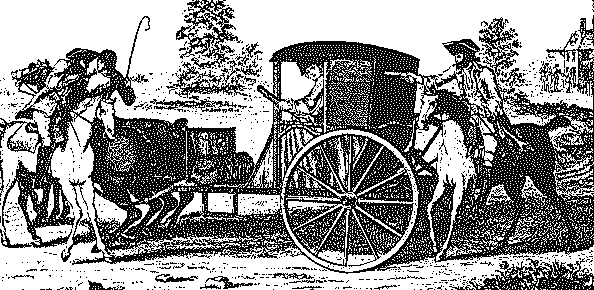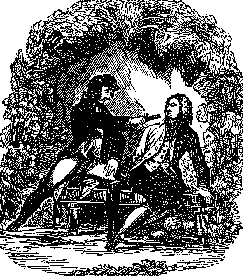

Highwaymen thrived in England in the seventeenth and eighteenth century, becoming legendary and romantic figures. Highwaymen were "as common as crows" from around 1650 to 1800. In an age where travel was already hazardous due to the lack of decent roads, no one rode alone without fear of being robbed, and people often joined company or hired escorts. Travelers often wrote their wills before they traveled.
The legend of the highwayman is that of a gentleman. High or low born, the legendary highwayman dressed well (with a kerchief over his face), was well-mannered, and used threats rather than violence. "Stand and Deliver" and "Your money or your life," were his greetings.
This legend is one of long standing. In 1737 the Abbe le Blanc wrote of Englishmen's attitudes toward highwaymen: "Tales of their cunning and generosity were in the mouths of everybody, and a noted thief was a kind of hero."(Newark, 21) Thomas de Quincey (1785-184) wrote that being a highwayman required "a bountiful endowment of qualifications; strength, health, agility, and excellent horsemanship" and that "the very noblest specimen of man, considered as an animal, were the mounted robbers who cultivated their profession on the great roads." (Newark, 22) Henry Fielding was so concerned about the romanticism attached to the highwayman, that he asked Garrick to suppress his production of The Beggar's Opera, which made a hero out of a highwayman. (Newark, 25)
Although there were well-born and well-mannered highwaymen, they were far outnumbered by those who practiced their trade with brutality. Violence and rape were common. When Tom Wilmot had difficulty removing a woman's ring, he cut off her finger.(Newark, 27)
The gentleman highwayman has its origins in the English Civil Wars. When Charles I was defeated, many Royalist officers were ruined, their estates confiscated, and they were left without resources. These cavaliers set the pattern for the gentleman robber. Condemned to the gallows, former Cavalier Captain Phillip Stafford wore his finest clothes, and had a final drink at a tavern, promising to pay for it on his way back. Captain James Hind was the epitome of the gentleman robber. Hind was not a gentleman by birth, but the son of a saddlemaker who had a distinguished career in the civil war. He was also known to help the poor. Hind fought with Charles II. In 1651 he was arrested and hanged, drawn and quartered for treason rather than robbery. (Lives, 61) Captain Zachary Howard, a former Cavalier, reportedly held up Cromwell himself. However, he was no gentleman. Learning Lord General Thomas Fairfax was sending supplies to his home, Howard attacked General Fairfax's house, raping Lady Fairfax and her daughter while Fairfax was away.
The four main roads to London were infamous for their criminal activity. On the Great Western Road, Hounslow Heath was notorious for its highwaymen. Robbers on the Great North Road included Dick Turpin. The Dover Road had two infamous spots, Gad's Hill and Shooter's Hill. And John Cotinton, aka "Mulled Sack," stole 4,000 pounds from an army wagon on the Oxford Road. Wimbledon Common, Blackheath, Barnes Common, Bagshort Heath; all were frequented by robbers. Salisbury Plain was also noted for its highwaymen. The establishment of the public stagecoach in 1658 gave highwaymen a new target. Security and transportation improved somewhat after 1734 when the coaches began to carry mail, but despite the greater speed and increased escort there was no guarantee of safety.
The demise of the highwayman began with the establishment of the Horse Patrol around London in 1805, and was furthered by the founding of the Metropolitan Police in 1829. Although highwaymen persisted in isolated areas, the growth of a paid police force meant their heyday was over. The last major gang was the "the Hanham and Cock-road Gang," a group of five men who robbed and brutalized residents around Brislington and Kensham. They were apprehended by a police sergeant in 1850. (Newark, 34)
